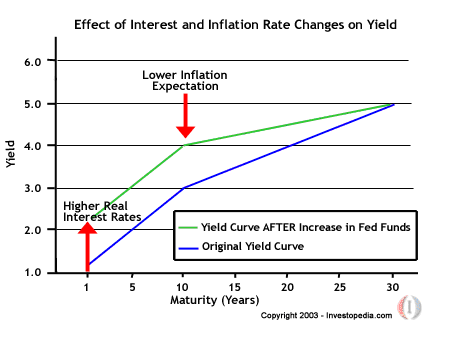Bond Basics The Federal Reserve The Yield Curve and Bond Prices
Post on: 22 Июль, 2015 No Comment

Today we are going to talk about bond basics meaning the things you will need to know throughout your Learn Bonds journey including, the Federal Reserve, The Yield Curve and how bond prices move. Lets get started.
Learn More about the Topics mentioned in this video:
Bond Basics Video Script
The first topic we will touch on in our bond basics lesson is the Fed. The federal reserve has a humongous influence over interest rates and the economy. One of the primary tools they use is open market operations. This is where the Fed buys and sells short term treasuries in order to raise or lower the interest rate that banks charge to lend each other money overnight.
When the Fed goes into the market and buys treasuries they increase the money supply. This sends interest rates lower and should stimulate the economy. When the fed sells treasuries the money that they receive is taken out of circulation, reducing the money supply. This sends interest rates higher which should slow economic growth. (You can learn more about the Fed here )
Why would the Fed ever want to slow economic growth? Because they are worried about the second topic in our bond basics lesson, inflation. Inflation is the general increase in prices over time, which makes your money worth less and less.
Inflation is also one of the reasons why normally a long term bond will pay a higher rate of interest than a short term bond. Investors want to be paid not only for tying their money up for longer periods of time, but also for the purchasing power that they are likely to lose over that time due to inflation. (you can learn more about inflation here )
By comparing the yields on the same type of bond with different maturities we can see how much more investors require for locking their money up for longer periods of time. When you put this on a graph you get what is known as the yield curve, the third topic of our bond basics lesson.
The slope of the yield curve changes based on the market’s perceptions of economic growth and inflation. Because of this by watching the yield curve in the market data section here at Learn Bonds you can get clues as to where the economy is headed. It is also helpful in determining which maturity of bond you should buy, by looking at how much extra you can earn for tying you money up for longer periods of time. (you can learn more about the yield curve here )
The last topic in our bond basics lesson is sensitivity to interest rates.

Bond Prices and interest rates have an inverse relationship. If interest rates rise then all else being the value of that bond will fall. If interest rates move lower then all else being equal the value of a bond will rise.
This is because normally the interest payments you receive on a bond and the principal that you receive back when the bond matures are both fixed for the life of the bond. If interest rates rise after you purchase a bond, then new investors can get a new bond paying a higher fixed rate of interest. In this situation the only way to get a new investor to accept a lower rate of interest on an existing bond, is to lower the price of that bond. On the other hand, If interest rates fall, then investors will be willing to pay a premium for the old bond which has the higher fixed rate of interest.
The longer a bond has until maturity the greater the price fluctuations will be as interest rates change. This is also known as interest rate risk or duration. (You can learn more about duration here )
Thats our bond basics lesson for today. Thanks for watching and feel free to leave any comments or questions in the comments section below. Stay tuned for our next lesson where we will cover porfolio diversification, income, and bonds vs bond funds.
For more great bond information visit us at learnbonds.com, on twitter @learnbonds, and on facebook at www.facebook.com/learnbondspage














